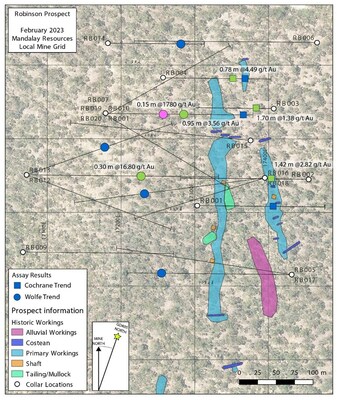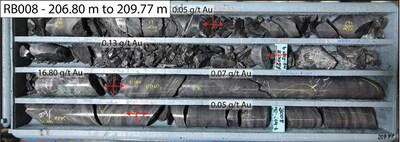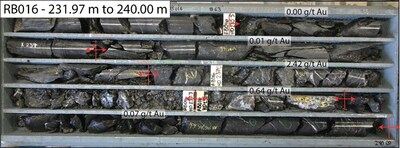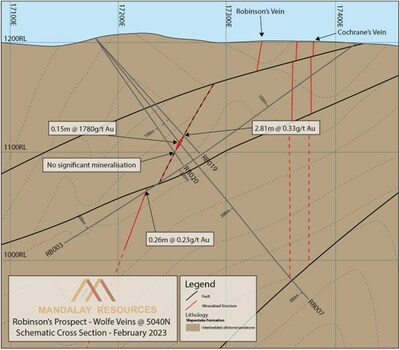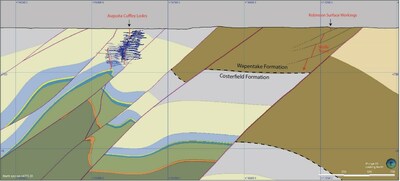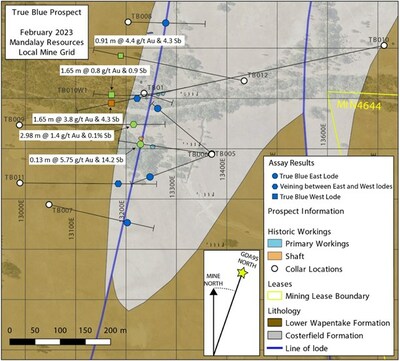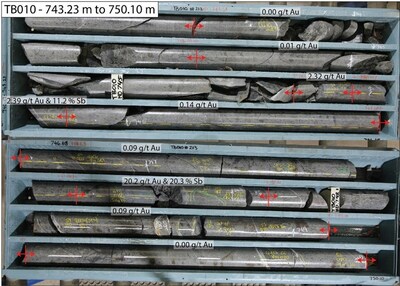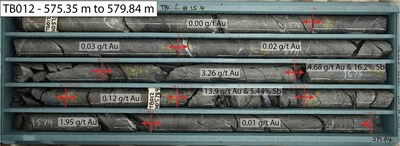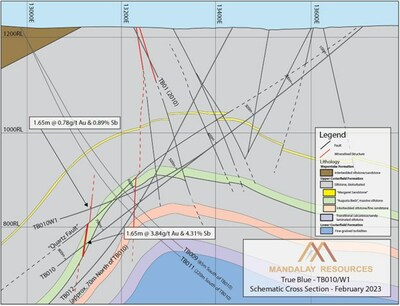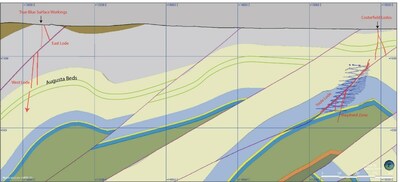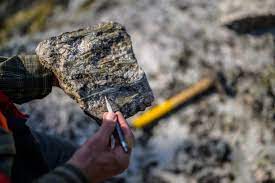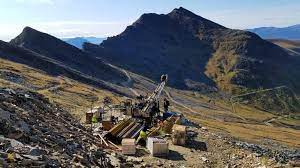Drilling News
MANDALAY RESOURCES CORPORATION PROVIDES AN EXPLORATION UPDATE ON THE ROBINSON PROSPECT AND ANNOUNCES EARLY SUCCESS AT THE TRUE BLUE DEEP DRILLING PROGRAM, 2.5 KM FROM THE OPERATING MINE AT COSTERFIELD
MANDALAY RESOURCES CORPORATION PROVIDES AN EXPLORATION UPDATE ON THE ROBINSON PROSPECT AND ANNOUNCES EARLY SUCCESS AT THE TRUE BLUE DEEP DRILLING PROGRAM, 2.5 KM FROM THE OPERATING MINE AT COSTERFIELD
Canada NewsWire
TORONTO, Feb. 28, 2023
TORONTO,…

MANDALAY RESOURCES CORPORATION PROVIDES AN EXPLORATION UPDATE ON THE ROBINSON PROSPECT AND ANNOUNCES EARLY SUCCESS AT THE TRUE BLUE DEEP DRILLING PROGRAM, 2.5 KM FROM THE OPERATING MINE AT COSTERFIELD
Canada NewsWire
TORONTO, Feb. 28, 2023
TORONTO, Feb. 28, 2023 /CNW/ – Mandalay Resources Corporation (“Mandalay” or the “Company”) (TSX: MND) (OTCQB: MNDJF) is pleased to provide an update on the drilling campaigns at the Robinson and True Blue Prospects at its Costerfield Operation (Victoria, Australia).
Drilling Highlights:
- 12-hole diamond drill program confirms the presence of gold anomalism along the Wolfe Trend at Robinson Prospect; however, Mandalay has not been able to replicate the exceptional grade of 1,780 g/t over 0.17 meters (“m”) (see news release dated June 9, 2022).
- Deep drilling at the True Blue Prospect has identified subvertical quartz-stibnite veining west of the historically mined lode with substantial grade intercepted in 2 drill holes:
- 3.8 g/t gold and 4.3% antimony over 2.57 m (estimated true width (“ETW”) of 1.65 m) in TB010, including 20.2 g/t gold and 20.3% antimony over 0.44 m (ETW 0.31 m); and
- 4.4 g/t gold and 4.3% antimony over 1.82 m (ETW of 0.91 m) in TB012
|
Note: Further intercept details can be found in Table 1 and Table 2 in the Appendix to this document. |
Dominic Duffy, President and CEO of Mandalay, commented:
“We are pleased to provide an update on the Robinson Prospect drilling program and report encouraging results from our ongoing drill testing campaign at the True Blue Prospect situated 2.5 km to the west of the Shepherd and Youle mine.
“After the initial exciting drill result of 1,780 g/t gold over 0.17 m (see news release dated June 9, 2022) early in the Robinson deep drilling program, the schedule was accelerated with the addition of a second drill rig. Over the proceeding months an additional 12 holes were drilled with mixed results showing strong structural continuity, but little grade continuity for the mineralization. A geochemical study of the Costerfield system, ongoing at the time, suggests that the nuggety properties of the mineralization found at Robinson could be linked to the host rocktype with a more favourable setting underlying the tested area.
“In light of the updated mineralization model, the Robinson Prospect was put on hold and drilling commenced on the True Blue prospect approximately 2.5 kilometres to the West of the current mine at Youle. While there was historic mining at True Blue and some drill testing success in 2020, interest was heightened due to the favourable host rock setting that is shared with Youle and Cuffley and underlies the Robinson prospect.
“The initial results of the True Blue program are encouraging and the best results so far are within the theorized, favourable stratigraphic setting. The intercepts are similar in grade and minerology to the upper mineralized levels of the central corridor where mining began in 2006, supporting the updated mineralization model. Drilling will continue on the True Blue prospect applying understanding from the Augusta to Youle mineral corridor as an analogue to potentially find a new high-grade mineral field.”
Robinson Prospect Drilling Program Update
Located approximately 2 km east of the Augusta mine site in the Costerfield State Forest, Robinson Prospect is characterized by extensive surface workings and several shafts that were sunk on the two historically mined lodes, the Cochrane and Robinson lodes. Mandalay designed and executed a drilling program in 2022 to identify the continuation of the Robinson line of lode at depth, as well as strike extensions.
We achieved early success on the initial five holes of the 2022 drill testing program at Robinson’s, with RB007 intercepting 1,780 g/t gold over true width of 0.15 m hosted in a breccia vein ~80 m to the west of the historically mined Robinson Lode, justifying a follow-up testing campaign. Since the release of the initial five holes of the drilling campaign (see new release dated June 9, 2022), a further 12 holes have been drilled to identify the nature and extent of the gold mineralization intercepted in RB007 (Figure 1).
Drilling delineated an area of gold anomalism broadly continuous along 350 m of strike. Intercepts within this trend are either well-developed quartz breccia like the intercept in RB008 (Fig. 2) or zones of intense stockwork veining with strong sulfide wall rock alteration like the intercept in RB016 (Fig. 3). Despite the lack of structural continuity, the spatial distribution of mineralized structures clearly defines a mineralized corridor of roughly north-south strike interpreted to be parallel to the historic Robinson workings.
This newly discovered mineralized corridor named Wolfe Trend appears to be a continuation of the surface mineralization of Robinson’s Lode progressively stepping westward at depth across several thrust faults. The ~200 m wide corridor is bound by at least two steep north-striking and highly sheared fault zones. Drilling results indicate that the system may have originally deformed under the west dipping thrusts with the sub-vertical faults crosscutting the earlier thrusts with minimal offset. Out of the two fault sets, the sub-vertical faults are interpreted to have introduced gold-bearing fluids into the prospect (Fig. 4). This is due to the presence of quartz veining, anomalous gold, and bleached bedding associated with these faults. From the damage zone between these sub-vertical faults, a discontinuous fracture network of meter scale veins formed through the brittle sandstone dominant layers of the Wapentake Formation that host the prospect. This fracture network hosts the gold bearing quartz veins and breccias intercepted within the Wolfe Trend.
Outlook
In the newly discovered Wolfe Trend, the 2022 drilling program successfully identified some of the strongest mineralization in the district and demonstrated the presence of a well-endowed mineral system extending at depth at the Robinson prospect. However, the gold mineralization appears to be dispersed across an extensive quartz-filled fracture network and gold bearing structures are challenging to continuously intercept. This is evidenced by the lack of continuity between gold grades above 0.5 g/t. This complex structural environment is largely a consequence of the brittle nature of the host sandstone layers of the Wapentake Formation, which accommodated the strain accumulated between the steep faults during the mineralizing event by developing a brittle, anastomozing fracture network.
The mineralized breccias of Robinson Prospect may potentially only represent the surface expression of a more cohesive mineral system at depth; district-scale structural and litho-stratigraphic modelling suggests that the geological and structural setting of the central corridor may be present at about 600 m depth under the sandstone-dominated Wapentake Formation turbidites (Fig. 5). The depth continuation of the Robinson mineral system may therefore be hosted in the same favourable lithostratigraphic environment that hosts classic Costerfield-style mineralization like that of the Youle and Cuffley deposits.
Recent drilling at the True Blue prospect is building on the favourable lithostratigraphic setting model and, once further supported, a deep drilling champaign will be designed to test the setting under Robinson.
True Blue Drilling Program Update
2020 Testing Program
The True Blue prospect includes a series of historic surface workings and coincident geochemical anomaly, hosted within the hinge zone of an anticline ~2.5 km to the west of the current Youle and Brunswick mine workings (Fig. 6). Two phases of diamond drill testing were completed at True Blue in 2020 to follow-up on a single diamond drill hole (TB01) drilled by Mandalay in 2010 under the surface workings to the north of the True Blue shaft.
The initial three-drillhole testing phase (see press release June 22, 2020) achieved early success in TB002 intercepting a steep east dipping quartz-stibnite vein grading at 5.8 g/t Au, and 14.2% Sb over 0.13 m (true width) interpreted to correspond to the down-dip extension of the True Blue lode intercept in TB01.
A second phase of testing consisted of four drillholes (TB005 to TB008) which continued testing the True Blue Lode after the initial success of TB002. Drilling intercepted weakly mineralized quartz veins with trace stibnite and sulphide wall rock alteration halos, delineating a strike of ~400 m of gold anomalism on the steep east dipping True Blue Lode. All significant intercepts of this second phase of drilling are hosted on the east limb of the True Blue anticline within a domain heavily disrupted by high frequency steep east dipping fault zones. Consequently, the intercepts exhibit poor structural and grade continuity.
TB005 and TB006 also intercepted a moderate northwest dipping thrust named the Quartz Fault. The Quartz Fault has distinctive quartz fill with strong sulphide alteration and is interpreted to constitute the lower bound of the True Blue lode. The Quartz Fault intercepts in TB005 and TB006 yield anomalous gold grades suggesting the fault could have provided a pathway for mineralizing fluids at the True Blue prospect. TB005 also intercepted stibnite veining below the Quartz Fault in an area that appears to be less disrupted by the thrust faulting observed further east, therefore indicating that a more prospective panel for Costerfield-style quartz-stibnite mineralization could exist below the Quartz Fault and further west on the west limb of the True Blue anticline.
2022 True Blue Deeps Program
Following a review of previous drilling results, the True Blue Deeps program was designed to test for the continuation of the True Blue mineralization below the Quartz Fault and away from the heavily faulted domain in the east limb of the True Blue anticline. The drilling program is currently under way and four drillholes have been completed to date.
TB009, the first hole in the True Blue Deeps program, was drilled west to east and collared ~400 m west of the TB002 collar location. This drillhole intercepted a 5-meter array of subvertical quartz-stibnite veins with anomalous gold below the Quartz Fault (Fig. 7). Gold grades for some veined intervals are in excess of 5 g/t Au with visible gold observed in a quartz-stibnite vein grading at 2.15 g/t Au. This mineralized zone is located to the west of the True Blue Lode and the stibnite veining below the Quartz Fault intercepted in TB005, suggesting a progressive westward stepping of the mineralization below the Quartz Fault. TB009 went on to intercept additional quartz-stibnite mineralization with gold grades in excess of 3 g/t.
TB010 was drilled east to west to test for subvertical mineralization below the Quartz Fault across the True Blue anticline. TB010 intercepted anomalous gold in a zone of highly strained quartz veins with trace stibnite interpreted to correlate with the vein array intercepted in TB009. High-grade mineralization was however intercepted further to the west of this veining, culminating with a steep west dipping stibnite vein grading at 20.2 g/t Au and 20.3% Sb over 0.28 m true width, the highest gold grade seen yet at the True-Blue Prospect (Fig. 7). This intercept and the associated massive stibnite and quartz-stibnite tension veining yielded a composite grade of 3.84 g/t Au and 4.31 % Sb at a true width of 1.65 m.
The high-grade gold intercept represents a newly discovered line of lode below the Quartz Fault called True Blue West Lode. The proximity of the high-grade intercept to the Augusta Beds, a key stratigraphic horizon of the Costerfield Siltstone that has been interpreted to produce a significant upgrade in gold grades in the upper part of the Augusta and Costerfield lodes, may also support a lithostratigraphic control on the upgrade in gold grades observed in this new line of mineralization.
A wedge hole was completed to test for the continuation of the True Blue West Lode into the hanging wall of the Quartz Fault up-dip the parent hole intercept. Despite the downgrade in gold grades from the parent hole intercept, TB010W1 successfully confirmed the continuation of the West Lode intercepting a stibnite vein followed by a highly strained fault with stibnite fill of similar orientation to the parent hole intercept and grading at 2.87 g/t Au and 3.45% Sb at 0.42 m true width.
TB011 was drilled ~200 m south of TB009 to test for the continuation of the True Blue West Lode to the south. TB011 intercepted stibnite veining yielding anomalous gold and stibnite grades (1.10 g/t Au and 6.89% Sb at 0.06 m true width) below the Quartz Fault. The current interpretation suggests that the veining could correspond to the southern extent of the veining intercepted in TB009, thus indicating that True Blue West Lode intercepted in TB010 and TB010W1 could lie further to the west if this drillhole.
The most recently completed hole (TB012) intercepted the continuation of the True Blue West Lode ~80 m north of the high-grade in TB010. The intercept comprises three stibnite veins within a two-meter zone of quartz-stibnite veining grading at 4.43 g/t Au and 4.32% Sb over 0.91 m true width (Fig. 8). Like TB010, this veining was intercepted below the Augusta Beds, further supporting the upgrade in gold grades of this line of mineralization below this stratigraphic horizon.
Outlook
The True Blue Deeps drilling program has successfully confirmed the depth continuation of the mineralization intercepted during the 2020 drilling campaign. More importantly, the deep drilling indicated the potential for a significant upgrade in gold grades at depth below the Quartz Fault.
Future drilling will focus on further testing this newly discovered line of lode on the west limb of the True Blue anticline and below the Augusta Beds to identify a continuation of the mineral system into the same litho-structural setting that hosts the classic high-grade Costerfield style-mineralization of the Youle and Cuffley deposits.
Drilling and Assaying
All diamond drill core was logged and sampled by Costerfield geologists. All samples were sent to On Site Laboratory Services (OSLS) in Bendigo, Victoria, Australia, for sample preparation and analysis by fire assay for gold, and Atomic Absorption Spectroscopy (AAS) for antimony. Samples featuring coarse grained visible gold were assayed using a variant of fire assay known as screen fire assay. This method is routinely used to mitigate potential problems associated with heterogeneity in the distribution of coarse gold within drill samples. The procedure collects all coarse heterogenous coarse gold by screening at 75µm after crushing and pulverisation, and subsequently fire assays the resultant mass to extinction. A mass weighted average of gold grade of the sample is subsequently calculated from the +75µm and -75µm fractions of the sample. Site geological and metallurgical personnel have implemented a QA/QC procedure that includes systematic submission of standard reference materials and blanks within batches of drill and face samples submitted for assay. Costerfield specific reference materials produced from Costerfield ore have been prepared and certified by Geostats Pty Ltd., a specialist laboratory quality control consultancy. See Technical Report entitled “Costerfield Operation, Victoria, Australia NI 43-101 Report” dated March 30, 2021, available on SEDAR (www.sedar.com) for a complete description of drilling, sampling, and assaying procedures.
Qualified Person:
Chris Davis, Vice President of Operational Geology and Exploration at Mandalay Resources, is a Chartered Professional of the Australasian Institute of Mining and Metallurgy (MAusIMM CP(Geo)), as well as a Member of the Australian Institute of Geoscientists (MAIG) and a Qualified Person as defined by NI 43-101. He has reviewed and approved the technical and scientific information provided in this release.
About Mandalay Resources Corporation
Mandalay Resources is a Canadian-based natural resource company with producing assets in Australia (Costerfield gold-antimony mine) and Sweden (Björkdal gold mine), with projects in Chile and Canada under closure or development status. The Company is focused on growing its production and reducing costs to generate significant positive cashflow. Mandalay is committed to operating safely and in an environmentally responsible manner, while developing a high level of community and employee engagement.
Mandalay’s mission is to create shareholder value through the profitable operation and continuing the regional exploration program, at both its Costerfield and Björkdal mines. Currently, the Company’s main objectives are to continue mining the high-grade Youle vein at Costerfield, bring the deeper Shepherd veins into production, both of which are expected to continue to supply high-grade ore to the processing plant, and to extend Youle’s Mineral Reserves. At Björkdal, the Company will aim to increase production from the Aurora zone and other higher-grade areas in the coming years in order to maximize profit margins from the mine
Forward-Looking Statements:
This news release contains “forward-looking statements” within the meaning of applicable securities laws, including statements regarding the exploration and development potential of the Robinson’s and True Blue Prospects (Costerfield). Readers are cautioned not to place undue reliance on forward-looking statements. Actual results and developments may differ materially from those contemplated by these statements depending on, among other things, changes in commodity prices and general market and economic conditions. The factors identified above are not intended to represent a complete list of the factors that could affect Mandalay. A description of additional risks that could result in actual results and developments differing from those contemplated by forward-looking statements in this news release can be found under the heading “Risk Factors” in Mandalay’s annual information form dated March 31, 2021, a copy of which is available under Mandalay’s profile at www.sedar.com. In addition, there can be no assurance that any inferred resources that are discovered as a result of additional drilling will ever be upgraded to proven or probable reserves. Although Mandalay has attempted to identify important factors that could cause actual actions, events or results to differ materially from those described in forward-looking statements, there may be other factors that cause actions, events or results not to be as anticipated, estimated or intended. There can be no assurance that forward-looking statements will prove to be accurate, as actual results and future events could differ materially from those anticipated in such statements. Accordingly, readers should not place undue reliance on forward-looking statements.
Appendix
Table 1. Significant intercepts of the Robinson’s Testing Drilling Program
|
DRILL HOLE ID |
FROM |
TO (M) |
DRILL |
TRUE |
AU |
SB |
AUEQ OVER |
SAMPLED |
|
RB007* |
125.11 |
125.28 |
0.17 |
0.15 |
1780 |
0.02 |
145.59 |
Wolfe Lode |
|
RB007* |
125.28 |
125.52 |
0.24 |
0.21 |
0.75 |
LLD |
0.09 |
Wolfe Lode |
|
RB007 |
168.45 |
169.55 |
1.1 |
0.95 |
3.56 |
LLD |
1.88 |
Unnamed vein |
|
including |
||||||||
|
RB007 |
168.45 |
168.89 |
0.44 |
0.38 |
2.55 |
LLD |
0.54 |
Unnamed vein |
|
RB007 |
168.89 |
169.05 |
0.16 |
0.14 |
4.19 |
LLD |
0.32 |
Unnamed vein |
|
RB007 |
169.3 |
169.55 |
0.25 |
0.22 |
8.2 |
LLD |
0.99 |
Unnamed vein |
|
RB007 |
190.5 |
191.17 |
0.67 |
0.58 |
1.07 |
LLD |
0.34 |
Unnamed vein |
|
RB007 |
276.96 |
277.43 |
0.47 |
0.41 |
2.38 |
0.03 |
0.55 |
Cochrane Lode |
|
RB007 |
295.71 |
296.05 |
0.34 |
0.29 |
1.24 |
LLD |
0.20 |
Cochrane Lode |
|
RB008 |
207.9 |
208.23 |
0.33 |
0.30 |
16.8 |
LLD |
2.84 |
Wolfe Lode |
|
RB008 |
403.12 |
404.12 |
1 |
0.71 |
0.86 |
LLD |
0.34 |
Cochrane Lode |
|
RB010 |
129.52 |
129.89 |
0.37 |
0.17 |
0.72 |
LLD |
0.07 |
Wolfe Lode |
|
RB012 |
148.32 |
148.48 |
0.16 |
0.11 |
1.01 |
LLD |
0.06 |
Unnamed vein |
|
RB012 |
186.31 |
186.79 |
0.48 |
0.37 |
0.66 |
LLD |
0.13 |
Unnamed vein |
|
RB013 |
172.94 |
173.35 |
0.41 |
0.36 |
0.67 |
LLD |
0.13 |
Unnamed vein |
|
RB013 |
206.25 |
206.4 |
0.15 |
0.13 |
0.53 |
LLD |
0.04 |
Wolfe Lode |
|
RB013 |
209.67 |
209.79 |
0.12 |
0.10 |
0.64 |
LLD |
0.04 |
Wolfe Lode |
|
RB014 |
148.56 |
148.78 |
0.22 |
0.19 |
1.64 |
LLD |
0.17 |
Wolfe Lode |
|
RB016 |
91.3 |
92.01 |
0.71 |
0.50 |
0.6 |
LLD |
0.17 |
Robinson Lode |
|
RB016 |
92.01 |
93 |
0.99 |
0.70 |
1.37 |
LLD |
0.53 |
Robinson Lode |
|
RB016 |
237.89 |
238.7 |
0.81 |
0.34 |
2.42 |
LLD |
0.46 |
Wolfe Lode |
|
RB016 |
238.85 |
239.16 |
0.31 |
0.13 |
0.64 |
LLD |
0.05 |
Wolfe Lode |
|
RB018 |
80 |
80.9 |
0.9 |
0.52 |
0.63 |
LLD |
0.18 |
Robinson Lode |
|
RB018 |
81.53 |
81.9 |
0.37 |
0.21 |
0.5 |
LLD |
0.06 |
Robinson Lode |
|
*previously released assay results |
||
|
Notes |
||
|
1. |
The AuEq (gold equivalent) grade is calculated using the following formula: |
|
|
AuEq g per t=Au g per t+Sb%× |
(Sb price per 10kg×Sb processing recovery) |
|
|
(Au price per g×Au processing recovery) |
||
|
Prices and recoveries used: Au $/oz = 1,700; Sb $/t = 11,700; Au Recovery = 93% and Sb Recovery = 95% |
||
|
2. |
LLD signifies an undetectable amount of antimony. Detection limit for the analysis used is 0.01% |
|
|
3. |
Composites that are not interpreted to be connected to a named vein or trend and are below 0.5 g/t Au are not considered significant and are not recorded here. |
|
Table 2. Significant intercepts of the True Blue Testing and True Blue Deeps programs
|
DRILL HOLE ID |
FROM |
TO (M) |
DRILL |
TRUE |
AU |
SB |
AUEQ |
SAMPLED |
|
TB005 |
33.34 |
33.85 |
0.51 |
0.36 |
1.11 |
0.04 |
0.24 |
Unnamed vein |
|
TB005 |
79.09 |
79.4 |
0.31 |
0.22 |
0.67 |
LLD |
0.08 |
Unnamed vein |
|
TB005 |
79.4 |
79.8 |
0.4 |
0.28 |
0.60 |
LLD |
0.09 |
Unnamed vein |
|
TB005 |
119.09 |
119.4 |
0.31 |
0.13 |
2.28 |
LLD |
0.16 |
Unnamed vein |
|
TB005 |
131.3 |
131.5 |
0.2 |
0.14 |
0.50 |
LLD |
0.04 |
Unnamed vein |
|
TB005 |
132 |
132.5 |
0.5 |
0.35 |
1.02 |
LLD |
0.20 |
Unnamed vein |
|
TB005 |
132.5 |
133.19 |
0.69 |
0.49 |
0.99 |
LLD |
0.26 |
Unnamed vein |
|
TB005 |
160.12 |
160.38 |
0.26 |
0.23 |
6.04 |
0.03 |
0.76 |
Unnamed vein |
|
TB005 |
160.38 |
160.73 |
0.35 |
0.30 |
0.52 |
LLD |
0.08 |
Unnamed vein |
|
TB005 |
246.42 |
246.8 |
0.38 |
0.27 |
1.04 |
LLD |
0.15 |
Unnamed vein |
|
TB005 |
252.59 |
252.76 |
0.17 |
0.08 |
0.63 |
LLD |
0.03 |
Unnamed vein |
|
TB005 |
256.29 |
256.51 |
0.22 |
0.10 |
0.60 |
LLD |
0.03 |
Unnamed vein |
|
TB005 |
275.22 |
275.65 |
0.43 |
0.21 |
0.60 |
LLD |
0.07 |
Quartz Fault |
|
TB005 |
275.65 |
275.93 |
0.28 |
0.14 |
0.76 |
LLD |
0.06 |
Quartz Fault |
|
TB005 |
275.93 |
276.05 |
0.12 |
0.06 |
1.47 |
LLD |
0.05 |
Quartz Fault |
|
TB005 |
281.39 |
281.53 |
0.14 |
0.05 |
1.74 |
2.88 |
0.23 |
Unnamed vein |
|
TB005 |
281.53 |
281.72 |
0.19 |
0.07 |
2.94 |
LLD |
0.12 |
Unnamed vein |
|
TB005 |
293.78 |
294.02 |
0.24 |
0.12 |
0.99 |
LLD |
0.06 |
Unnamed vein |
|
TB005 |
303.84 |
304.11 |
0.27 |
0.15 |
0.53 |
LLD |
0.04 |
Unnamed vein |
|
TB005 |
304.11 |
304.25 |
0.14 |
0.08 |
0.51 |
LLD |
0.02 |
Unnamed vein |
|
TB005 |
305.68 |
305.85 |
0.17 |
0.09 |
0.51 |
LLD |
0.03 |
Unnamed vein |
|
TB005 |
307.9 |
308.01 |
0.11 |
0.06 |
0.50 |
LLD |
0.02 |
Unnamed vein |
|
TB005 |
310.35 |
310.52 |
0.17 |
0.09 |
0.50 |
0.02 |
0.03 |
Unnamed vein |
|
TB006 |
82.5 |
82.65 |
0.15 |
0.09 |
0.89 |
LLD |
0.04 |
Unnamed vein |
|
TB006 |
82.65 |
82.8 |
0.15 |
0.09 |
0.70 |
LLD |
0.03 |
Unnamed vein |
|
TB006 |
165.4 |
165.7 |
0.3 |
0.21 |
2.13 |
LLD |
0.25 |
True Blue East Lode |
|
TB006 |
165.7 |
165.79 |
0.09 |
0.06 |
2.36 |
0.02 |
0.08 |
True Blue East Lode |
|
TB006 |
202 |
202.5 |
0.5 |
0.35 |
2.02 |
LLD |
0.39 |
Unnamed vein |
|
TB006 |
221.05 |
221.5 |
0.45 |
0.32 |
0.50 |
LLD |
0.08 |
Unnamed vein |
|
TB006 |
228.65 |
229.06 |
0.41 |
0.29 |
0.70 |
LLD |
0.11 |
Quartz Fault |
|
TB006 |
229.06 |
229.4 |
0.34 |
0.24 |
2.17 |
LLD |
0.29 |
Quartz Fault |
|
TB006 |
229.4 |
229.62 |
0.22 |
0.16 |
0.74 |
LLD |
0.06 |
Quartz Fault |
|
TB006 |
229.62 |
230 |
0.38 |
0.27 |
0.65 |
LLD |
0.09 |
Quartz Fault |
|
TB006 |
230 |
230.52 |
0.52 |
0.37 |
0.55 |
LLD |
0.11 |
Quartz Fault |
|
TB007 |
140.28 |
140.6 |
0.32 |
0.29 |
0.96 |
LLD |
0.15 |
Unnamed vein |
|
TB007 |
142.43 |
142.56 |
0.13 |
0.12 |
0.80 |
LLD |
0.05 |
Unnamed vein |
|
TB007 |
166.8 |
166.9 |
0.1 |
0.10 |
2.33 |
LLD |
0.12 |
Unnamed vein |
|
TB007 |
204.1 |
204.68 |
0.58 |
0.37 |
0.72 |
LLD |
0.14 |
Unnamed vein |
|
TB007 |
211.75 |
211.97 |
0.22 |
0.19 |
4.50 |
0.04 |
0.49 |
True Blue East Lode |
|
TB007 |
211.97 |
212.4 |
0.43 |
0.37 |
0.87 |
LLD |
0.18 |
Unnamed vein |
|
TB007 |
234.61 |
234.74 |
0.13 |
0.12 |
0.75 |
LLD |
0.05 |
Unnamed vein |
|
TB007 |
234.74 |
235.42 |
0.68 |
0.61 |
0.89 |
LLD |
0.29 |
Unnamed vein |
|
TB007 |
235.42 |
235.53 |
0.11 |
0.10 |
2.37 |
LLD |
0.13 |
Unnamed vein |
|
TB007 |
235.53 |
236.15 |
0.62 |
0.56 |
0.59 |
LLD |
0.18 |
Unnamed vein |
|
TB008 |
107.8 |
107.9 |
0.1 |
0.10 |
2.07 |
LLD |
0.11 |
True Blue East Lode |
|
TB008 |
186.91 |
187.1 |
0.19 |
0.13 |
1.72 |
LLD |
0.13 |
Unnamed vein |
|
TB008 |
187.1 |
187.37 |
0.27 |
0.19 |
1.01 |
LLD |
0.10 |
Unnamed vein |
|
TB008 |
195.2 |
195.75 |
0.55 |
0.28 |
1.79 |
LLD |
0.27 |
Unnamed vein |
|
TB008 |
196.15 |
196.57 |
0.42 |
0.21 |
1.86 |
LLD |
0.21 |
Unnamed vein |
|
TB008 |
196.57 |
197.15 |
0.58 |
0.29 |
1.22 |
LLD |
0.19 |
Unnamed vein |
|
TB009 |
384.42 |
384.52 |
0.1 |
0.07 |
0.61 |
LLD |
0.02 |
Unnamed vein |
|
TB009 |
385.52 |
385.68 |
0.16 |
0.11 |
0.74 |
LLD |
0.05 |
Unnamed vein |
|
TB009 |
386.68 |
392.04 |
5.36 |
2.98 |
1.44 |
0.08 |
1.61 |
Veining between True Blue East and West lodes |
|
including |
||||||||
|
TB009 |
386.68 |
386.93 |
0.25 |
0.18 |
1.22 |
0.02 |
0.12 |
|
|
TB009 |
386.93 |
387.32 |
0.39 |
0.28 |
6.10 |
0.02 |
0.94 |
|
|
TB009 |
388.25 |
388.67 |
0.42 |
0.30 |
0.92 |
0.01 |
0.16 |
|
|
TB009 |
388.67 |
389.09 |
0.42 |
0.30 |
0.78 |
0.03 |
0.14 |
|
|
TB009 |
389.09 |
389.34 |
0.25 |
0.18 |
0.90 |
LLD |
0.09 |
|
|
TB009 |
389.34 |
389.6 |
0.26 |
0.18 |
2.37 |
0.01 |
0.24 |
|
|
TB009 |
389.6 |
389.94 |
0.34 |
0.24 |
2.15 |
0.23 |
0.35 |
|
|
TB009 |
389.94 |
390.34 |
0.4 |
0.28 |
0.94 |
LLD |
0.14 |
|
|
TB009 |
390.34 |
390.57 |
0.23 |
0.16 |
0.75 |
LLD |
0.07 |
|
|
TB009 |
390.57 |
390.82 |
0.25 |
0.18 |
0.53 |
0.01 |
0.05 |
|
|
TB009 |
390.93 |
391.72 |
0.79 |
0.56 |
0.67 |
0.02 |
0.22 |
|
|
TB009 |
391.72 |
391.87 |
0.15 |
0.11 |
5.98 |
1.83 |
0.59 |
|
|
TB009 |
391.87 |
392.04 |
0.17 |
0.12 |
0.55 |
LLD |
0.04 |
|
|
TB009 |
400 |
400.74 |
0.74 |
0.52 |
0.93 |
LLD |
0.26 |
Unnamed vein |
|
TB009 |
400.74 |
400.9 |
0.16 |
0.11 |
2.47 |
0.06 |
0.16 |
Unnamed vein |
|
TB009 |
400.9 |
401.9 |
1 |
0.71 |
0.50 |
LLD |
0.19 |
Unnamed vein |
|
TB009 |
406.25 |
406.65 |
0.4 |
0.28 |
0.56 |
LLD |
0.08 |
Unnamed vein |
|
TB009 |
406.65 |
406.88 |
0.23 |
0.16 |
2.03 |
LLD |
0.18 |
Unnamed vein |
|
TB009 |
406.88 |
407.75 |
0.87 |
0.62 |
2.20 |
LLD |
0.74 |
Unnamed vein |
|
TB009 |
407.75 |
407.93 |
0.18 |
0.13 |
1.35 |
LLD |
0.09 |
Unnamed vein |
|
TB009 |
494 |
494.27 |
0.27 |
0.19 |
1.10 |
LLD |
0.11 |
Unnamed vein |
|
TB009 |
512.36 |
512.56 |
0.2 |
0.14 |
1.73 |
LLD |
0.13 |
Unnamed vein |
|
TB009 |
512.56 |
512.77 |
0.21 |
0.15 |
0.66 |
LLD |
0.05 |
Unnamed vein |
|
TB009 |
512.77 |
512.98 |
0.21 |
0.15 |
3.24 |
LLD |
0.27 |
Unnamed vein |
|
TB009 |
512.98 |
513.35 |
0.37 |
0.26 |
3.20 |
0.01 |
0.47 |
Unnamed vein |
|
TB010 |
621.46 |
621.68 |
0.22 |
0.16 |
1.08 |
0.01 |
0.10 |
Unnamed vein |
|
TB010 |
621.68 |
621.78 |
0.1 |
0.07 |
2.48 |
LLD |
0.10 |
Unnamed vein |
|
TB010 |
622.65 |
622.75 |
0.1 |
0.07 |
0.62 |
LLD |
0.02 |
Unnamed vein |
|
TB010 |
745.53 |
748.1 |
2.57 |
1.65 |
3.84 |
4.31 |
12.17 |
True Blue West Lode |
|
including |
||||||||
|
TB010 |
745.53 |
745.69 |
0.16 |
0.11 |
2.32 |
0.47 |
0.21 |
|
|
TB010 |
745.69 |
745.85 |
0.16 |
0.11 |
2.39 |
11.20 |
1.69 |
|
|
TB010 |
747.66 |
748.1 |
0.44 |
0.31 |
20.20 |
20.30 |
11.16 |
|
|
TB010 |
755.47 |
755.56 |
0.09 |
0.06 |
2.79 |
11.30 |
0.97 |
Subvertical stibnite vein |
|
TB010W1 |
654 |
654.53 |
0.53 |
0.37 |
0.54 |
LLD |
0.11 |
Unnamed vein |
|
TB010W1 |
698.28 |
700.18 |
1.9 |
1.65 |
0.78 |
0.89 |
2.49 |
True Blue West Lode |
|
including |
||||||||
|
TB010W1 |
699.28 |
699.77 |
0.49 |
0.35 |
2.87 |
3.45 |
2.00 |
|
|
TB011 |
319.82 |
319.99 |
0.17 |
0.12 |
0.96 |
LLD |
0.06 |
Unnamed vein |
|
TB011 |
319.99 |
320.99 |
1 |
0.71 |
0.88 |
LLD |
0.34 |
Unnamed vein |
|
TB011 |
335.13 |
335.52 |
0.39 |
0.28 |
1.67 |
LLD |
0.25 |
Unnamed vein |
|
TB011 |
366.4 |
366.72 |
0.32 |
0.23 |
0.57 |
LLD |
0.07 |
Unnamed vein |
|
TB011 |
366.72 |
367.17 |
0.45 |
0.32 |
0.71 |
LLD |
0.12 |
Unnamed vein |
|
TB011 |
367.17 |
367.27 |
0.1 |
0.07 |
1.10 |
6.89 |
0.64 |
Unnamed vein |
|
TB012 |
577.43 |
579.25 |
1.82 |
0.91 |
4.43 |
4.32 |
7.02 |
True Blue West Lode |
|
including |
||||||||
|
TB012 |
577.43 |
577.89 |
0.46 |
0.23 |
3.26 |
2.01 |
0.98 |
True Blue West Lode |
|
TB012 |
577.89 |
578.2 |
0.31 |
0.16 |
4.68 |
16.20 |
3.45 |
True Blue West Lode |
|
TB012 |
578.2 |
578.48 |
0.28 |
0.14 |
0.12 |
0.14 |
0.03 |
True Blue West Lode |
|
TB012 |
578.48 |
578.78 |
0.3 |
0.15 |
13.90 |
5.44 |
2.15 |
True Blue West Lode |
|
TB012 |
578.78 |
579.25 |
0.47 |
0.24 |
1.95 |
0.51 |
0.40 |
True Blue West Lode |
|
Notes |
||
|
4. |
The AuEq (gold equivalent) grade is calculated using the following formula: |
|
|
AuEq g per t=Au g per t+Sb%× |
(Sb price per 10kg×Sb processing recovery) |
|
|
(Au price per g×Au processing recovery) |
||
|
Prices and recoveries used: Au $/oz = 1,700; Sb $/t = 11,700; Au Recovery = 93% and Sb Recovery = 95% |
||
|
5. |
LLD signifies an undetectable amount of antimony. Detection limit for the analysis used is 0.01% |
|
|
6. |
Composites that are not interpreted to be connected to a named vein or trend and are below 0.5 g/t Au are not considered significant and are not recorded here. |
|
View original content to download multimedia:https://www.prnewswire.com/news-releases/mandalay-resources-corporation-provides-an-exploration-update-on-the-robinson-prospect-and-announces-early-success-at-the-true-blue-deep-drilling-program-2-5-km-from-the-operating-mine-at-costerfield-301757210.html
SOURCE Mandalay Resources Corporation
drilling
drill program
intercepts
drill hole
tsx-mnd
mandalay-resources-corporation
mandalay resources corporation
press-release

Valhalla Metals reports 21 metres of 6.84% CuEq at Sun Project, Alaska
Valhalla Metals Inc. [TSXV-VMXX; OTCQB-VMXXF] reported assay results from four diamond drill holes totaling 1,104…
Capella Announces Definitive Agreement for the Sale of is Central Norway Copper-Cobalt Projects to NickelX and Financing Update
Capella Announces Definitive Agreement for the Sale of is Central Norway Copper-Cobalt Projects to NickelX and Financing Update
Canada NewsWire
VANCOUVER, BC, Oct. 17, 2023
VANCOUVER, BC, Oct. 17, 2023 /CNW/ – Capella Minerals Ltd (TSXV: CMIL) (OTC…
Canada Silver Cobalt Works Confirms Pegmatites up to 20 meters wide and 70 meters long at Sangster West
Pegmatite Confirmations and Advanced Geochemical Insights Propel Exploration Success
Coquitlam, BC – TheNewswire – October 17, 2023 – Canada Silver…
